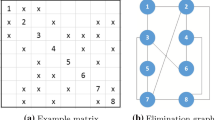Abstract
In this paper we discuss some instances where dense matrix techniques can be utilized within a sparse simplex linear programming solver. The main emphasis is on the use of the Schur complement matrix as a part of the basis matrix representation. This approach enables to represent the basis matrix as an easily invertible sparse matrix and one or more dense Schur complement matrices. We describe our variant of this method which uses updating of the QR factorization of the Schur complement matrix. We also discuss some implementation issues of the LP software package which is based on this approach.
Similar content being viewed by others
References
L. Aittoniemi, Basis representation in large-scale linear programming software,Operations Research Proceedings 1988 (Springer, Berlin-Heidelberg-New York, 1989).
M. Benichou, J.M. Gauthier, G. Hentges and G. Ribière, The efficient solution of large-scale linear programming problems-Some algorithmic techniques and computational results, Math. Progr. 13(1977)280–322.
J. Bischop and A. Meeraus, Matrix augmentation and partitioning in the updating of the basis inverse, Math. Progr. 13(1977)241–254.
T.F. Coleman,Large Sparse Numerical Optimization (Springer, Berlin-Heidelberg-Tokyo, 1984).
R.W. Cottle, Manifestations of the Schur complement, Lin. Alg. Appl. 8(1974)189–211.
G.B. Dantzig,Linear Programming and Extensions (Princeton University Press, Princeton, 1963).
I.S. Duff, A.M. Erisman and J.K. Reid,Direct Methods for Sparse Matrices (Clarendon Press, Oxford, 1989).
R. Fletcher and F.P.J. Matthews, Stable modification of explicit LU factors for simplex updates, Math. Progr. 30(1984)267–284.
J.J.H Forrest and J.A. Tomlin, Updated triangular factors of the basis to maintain sparsity in the product form simplex method, Math. Progr. 2(1972)263–278.
P.E. Gill, W. Murray, M.A. Saunders and M.H. Wright, A practical anti-cycling procedure for linearly constrained optimization, Math. Progr. 45(1989)437–474.
G.H. Golub and C.F. Van Loan,Matrix Computations (Oxford Academic, London, 1986).
J. Gondzio, On exploiting original problem data in the inverse representation of linear programming bases, Report ZTSW-1-A1214/90, System Research Institute, Polish Academy of Sciences (1990), to appear in ORSA J. Comput.
J. Gondzio, Stable algorithm for updating dense LU factorization after row or column exchange and row and column addition or deletion, Optimization 23(1992)7–26.
F. Gustavson, Finding the block lower triangular form of a sparse matrix, in:Sparse Matrix Computations, eds. J.R. Bunch and D.J. Rose (Academic Press, New York, 1976) pp. 275–289.
E. Hellerman and D. Rarick, Reinversion with the preassigned pivot procedure, Math. Progr. 1(1971)195–216.
R.V. Helgason and J.L. Kennington, Spike swapping in basis reinversion, Naval Res. Log. Quarterly 27(1980)697–701.
R.V. Helgason and J.L. Kennington, A note on splitting the bump in an elimination factorization, Naval Res. Log. Quarterly 29(1982))169–178.
J.J. Judice, G. Mitra and M. Tamiz, A program to reorder and solve sparse unsymmetric linear systems using an envelope method, Technical Report/04/87, Dept. of Math. & Stats, Brunel University, UK.
I.J. Lustig, An analysis of an available set of linear programming test problems, Comp. Oper. Res. 16(1989)173–184.
G. Mitra and M. Tamiz, Alternative methods for representing the inverse of linear programming basis matrices,13th Int. Symp. on Mathematical Programming, Tokyo (1988).
U.H. Suhl and L.M. Suhl, Computing sparse LU factorization for large-scale linear programming bases, ORSA J. Comput. 2(1990)325–335.
Author information
Authors and Affiliations
About this article
Cite this article
Barle, J., Grad, J. On the use of dense matrix techniques within sparse simplex. Ann Oper Res 43, 1–14 (1993). https://doi.org/10.1007/BF02025532
Issue Date:
DOI: https://doi.org/10.1007/BF02025532




